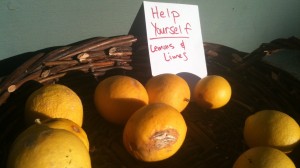This time of year, a lot of lemons, limes, and oranges are moldering in fridges and fruit bowls. The problem: We have trouble realistically gauging how much of it and how quickly we can eat fresh. The temptation are so great at the market, we lumber home with sackfuls of the stuff. Or perhaps the trees in the backyard are dropping their yield faster than we can get to it...

This is the time of year my colleagues dump shopping bags full of Eureka and Meyer lemons on the newsroom table. Takers abound, even if they're just adding to the piles at home.
I recently talked with Evan Kleiman, host of KCRW’s "Good Food," for the California Report. She says the nature of citrus temptation has shifted over the last 10 years or so. “It seems that we’ve gone from just a couple of varieties, even in the farmers markets...Now, it’s just this complete rainbow.”
One quick glance at UC Riverside’s citrus variety collection, and you can see how vast the rainbow really is. Alphabetically, the list ranges from the Abhayapuri lime to the Zhuluan sour orange hybrid.
Because of this plethora of varieties - some of the fruit are sun worshipers, others are lovers of coastal cool - most Californians can enjoy hyper-locally grown citrus. Northerners at this time of year may be limited to lemons, because a mandarin takes forever to sweeten close to the coast. But travel to the inland counties of the Bay Area, and your host will be foisting bags of mandarins and oranges on you as you head out the door. Southern Californians enjoy citrus year-round, but let's not dwell on that aromatic fact right now.